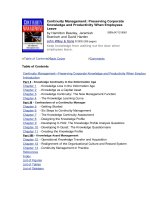John wiley sons carpenters and builders layout foundation and framing (2005) 7ed tlf lotb
Bạn đang xem bản rút gọn của tài liệu. Xem và tải ngay bản đầy đủ của tài liệu tại đây (7.14 MB, 311 trang )
TM
Audel
Carpenters and Builders
Layout, Foundation,
and Framing
All New 7th Edition
Mark Richard Miller
Rex Miller
TLFeBOOK
Vice President and Executive Group Publisher: Richard Swadley
Vice President and Publisher: Joseph B. Wikert
Executive Editor: Carol A. Long
Editorial Manager: Kathryn A. Malm
Development Editor: Kevin Shafer
Production Editor: Angela Smith
Text Design & Composition: TechBooks
Copyright c 2005 by Wiley Publishing, Inc., Indianapolis, Indiana. All rights reserved.
Published simultaneously in Canada
No part of this publication may be reproduced, stored in a retrieval system or transmitted in any
form or by any means, electronic, mechanical, photocopying, recording, scanning or otherwise,
except as permitted under Sections 107 or 108 of the 1976 United States Copyright Act, without
either the prior written permission of the Publisher, or authorization through payment of the
appropriate per-copy fee to the Copyright Clearance Center, 222 Rosewood Drive, Danvers, MA
01923, (978) 750-8400, fax (978) 646-8600. Requests to the Publisher for permission should be
addressed to the Legal Department, Wiley Publishing, Inc., 10475 Crosspoint Blvd., Indianapolis,
IN 46256, (317) 572-3447, fax (317) 572-4355, e-mail:
Limit of Liability/Disclaimer of Warranty: The publisher and the author make no representations or warranties with respect to the accuracy or completeness of the contents of this work
and specifically disclaim all warranties, including without limitation warranties of fitness for a
particular purpose. No warranty may be created or extended by sales or promotional materials.
The advice and strategies contained herein may not be suitable for every situation. This work
is sold with the understanding that the publisher is not engaged in rendering legal, accounting,
or other professional services. If professional assistance is required, the services of a competent
professional person should be sought. Neither the publisher nor the author shall be liable for
damages arising herefrom. The fact that an organization or Website is referred to in this work
as a citation and/or a potential source of further information does not mean that the author or
the publisher endorses the information the organization or Website may provide or recommendations it may make. Further, readers should be aware that Internet Websites listed in this work
may have changed or disappeared between when this work was written and when it is read.
For general information on our other products and services please contact our Customer Care
Department within the United States at (800) 762-2974, outside the United States at (317) 5723993 or fax (317) 572-4002.
Trademarks: Wiley, the Wiley Publishing logo, Audel, and The Books That Work are trademarks
or registered trademarks of John Wiley & Sons, Inc. and/or its affiliates. All other trademarks
are the property of their respective owners. Wiley Publishing, Inc., is not associated with any
product or vendor mentioned in this book.
Wiley also publishes its books in a variety of electronic formats. Some content that appears in
print may not be available in electronic books.
Library of Congress Control Number: 2004110824
eISBN: 0-7645-7987-8
Printed in the United States of America
10 9 8 7 6 5 4 3 2 1
Contents
Acknowledgments
xiii
About the Authors
xv
Introduction
Chapter 1
xvii
Locating a Building
Selection of Site
Staking Out
The Lines
Laying Out with Transit Instruments
Method of Diagonals
Points on Layout
Summary
Review Questions
1
1
1
1
2
3
5
6
7
Chapter 2
House Foundations
Slab-on-Grade
Crawl Space
Basement Construction
Pile Foundation
All-Weather Wood Foundation
Summary
Review Questions
9
9
15
21
22
22
23
24
Chapter 3
Concrete Forms and Hardware
Need for Strength
Bracing
Economy
Fastening and Hardware
Lumber for Forms
25
25
26
27
28
28
Practicality
Texture
Size and Spacing
Stripping Forms
Stripping Forms for Arches
31
34
34
34
38
v
vi Contents
Chapter 4
Special Forms
Prefabricated Forms
Summary
Review Questions
38
41
41
42
Site Equipment
Ladders
43
43
Setting Up a Ladder
Ladder Shoes
Ladder Accessories
Special Products
Ladder Safety
Scaffolding
Scaffolding Components
Scaffolding Safety Rules
Chapter 5
49
49
51
51
55
56
56
62
Summary
Review Questions
71
72
Concrete-Block Construction
Block Building Materials
73
74
Standard Masonry Units
Mortar
Block Building Methods
Basic Block-Laying
Laying Blocks at Corners
Building Walls Between Corners
Construction Methods
Walls
Building Interior Walls
Sills and Plates
Installation of Heating and Ventilating Ducts
Electrical Outlets
Insulation
Flashing
Floors
Summary
Review Questions
74
76
77
77
79
80
85
85
87
87
88
88
90
91
92
96
97
Contents vii
Chapter 6
Frames and Framing
Methods of Framing
Balloon-Frame Construction
Post-and-Beam Construction
Platform Frame Construction
Framing Terms
Sills
Girders
Joists
Subflooring
Headers and Trimmers
Walls and Partitions
Ledger Plates
Braces
Studs
Bridging
Rafters
Lumber Terms
Standard Sizes of Lumber
Framing Lumber
Chapter 7
99
99
99
99
99
100
100
102
103
103
104
104
106
106
106
107
107
107
107
108
Summary
Review Questions
109
109
Floors, Girders, and Sills
Girders
111
111
Construction of Girders
Placing Basement Girders
Sills
Types of Sills
Anchorage of Sill
Setting the Sills
Floor Framing
Connecting Joist to Sills and Girders
Bridging
Headers and Trimmers
Subflooring
111
111
114
115
116
116
117
117
118
118
121
viii Contents
Chapter 8
Summary
Review Questions
122
122
Constructing Walls and Partitions
Built-Up Corner Posts
Bracing
Preparing the Corner Posts and Studding
Erecting the Frame
Framing Around Openings
125
125
126
126
126
127
Headers
Size of Headers
Opening Sizes for Windows and Doors
128
128
129
Interior Partitions
Partitions Parallel to Joists
Partitions at Right Angles to Joists
Engineered Wood and I-Joist Open
Metal Web System
Labor and Material Costs Reduction
Chapter 9
130
130
131
131
132
Summary
Review Questions
137
137
Framing Roofs
Types of Roofs
Roof Construction
Rafters
Length of Rafter
Rafter Cuts
139
139
141
143
146
151
Common Rafter Cuts
Hip and Valley Rafter Cuts
Side Cuts of Hip and Valley Rafters
151
153
159
Backing of Hip Rafters
Jack Rafters
159
161
Shortest-Jack Method
Longest-Jack Method
Framing-Table Method
Jack-Rafter Cuts
162
162
163
163
Method of Tangents
164
Contents ix
Octagon Rafters
Trusses
Dormers
Summary
Review Questions
165
167
169
171
172
Chapter 10
Framing Chimneys and Fireplaces
Prefabricated Fireplaces
Contemporary Design
Summary
Review Questions
173
173
173
177
178
Chapter 11
Roofs and Roofing
Slope of Roofs
Selecting Roofing Materials
Roll Roofing
The Built-Up Roof
Wood Shingles
179
182
182
183
184
186
Hips
Valleys
190
190
Asphalt Shingles
Slate
Gutters and Downspouts
Summary
Review Questions
192
197
199
201
201
Chapter 12
Skylights
Residential Skylights
Skylight Maintenance
Tube-Type Skylights
Installation
Summary
Review Questions
203
205
207
213
213
216
216
Chapter 13
Cornice Details
Box Cornices
Closed Cornices
Wide Box Cornices
219
219
219
220
x Contents
Chapter 14
Chapter 15
Chapter 16
Open Cornices
Cornice Returns
Rake or Gable-End Finish
Summary
Review Questions
220
221
223
224
225
Doors
Manufactured Doors
227
227
Sash and Paneled Doors
Flush Doors
Louver Doors
227
227
229
Installing Mill-Built Doors
229
Door Frames
Doorjambs
Door Trim
230
230
232
Hanging Doors
Swinging Doors
Sliding Doors
Garage Doors
Summary
Review Questions
234
235
235
236
241
242
Windows
Window Framing
Double-Hung Windows
Hinged or Casement Windows
Gliding, Bow, Bay, and Awning Windows
Window Sash
243
244
244
245
245
246
Sash Installation
Sash Weights
Glazing Sash
247
247
248
Shutters
Summary
Review Questions
250
250
250
Siding
Fiberboard Sheathing
Wood Sheathing
251
251
251
Contents xi
Plywood Sheathing
Urethane and Fiberglass
Sheathing Paper
Wood Siding
Bevel Siding
Square-Edge Siding
Vertical Siding
Plywood Siding
Preservative Treatment
Wood Shingles and Shakes
252
254
254
255
256
257
257
258
259
259
Installation of Siding
259
Types of Nails
Corner Treatment
262
262
Metal Siding
Vinyl Siding
Summary
Review Questions
264
264
265
266
Appendix
267
Index
269
Acknowledgments
No book can be written without the aid of many people. It takes a
great number of individuals to put together the information available about any particular technical field into a book. Many firms
have contributed information, illustrations, and analysis to the
book.
The authors would like to thank every person involved for his
or her contributions. Following are some of the firms that supplied
technical information and illustrations.
American Plywood Association
Bilco Company
Billy Penn Gutters
National Forest Products Association
Owens-Corning
Portland Cement Association
Scholtz Homes, Inc.
Shetter-Kit, Inc.
Stanley Tools
Truswal Systems Corp.
Waco Scaffolding and Equipment
xiii
About the Authors
Mark Richard Miller finished his BS in New York and moved on
to Ball State University, where he earned a master’s degree, then
went to work in San Antonio. He taught high school and finished
his doctorate in College Station, Texas. He took a position at Texas
A&M University in Kingsville, Texas where he now teaches in the
Industrial Technology Department as a Professor and Department
Chairman. He has co-authored 11 books and contributed many
articles to technical magazines. His hobbies include refinishing a
1970 Plymouth Super Bird and a 1971 Road-runner.
Rex Miller was a Professor of Industrial Technology at The State
University of New York, College at Buffalo for more than 35 years.
He has taught at the technical school, high school, and college level
for more than 40 years. He is the author or co-author of more than
100 textbooks ranging from electronics through carpentry and sheet
metal work. He has contributed more than 50 magazine articles over
the years to technical publications. He is also the author of seven
Civil War regimental histories.
xv
Introduction
The Audel Carpenters and Builders Layout, Foundation, and Framing: All New Seventh Edition is the third of four volumes that cover
the fundamental tools, methods, and materials used in carpentry,
woodworking, and cabinetmaking.
This volume was written for anyone who wants (or needs) to
understand how the layout of a project or building is done; how the
foundation of a house is constructed; and how to frame a house. The
problems encountered here can make or ruin a house or any project.
Problems encountered by the carpenter, woodworker, cabinetmaker,
or do-it-yourselfer often need attention by someone familiar with the
requirements of the job well-done. Whether remodeling an existing
home or building a new one, the rewards of doing a good job are
great.
This book has been prepared for use as a practical guide in the selection, maintenance, installation, operation, and repair of wooden
structures. Carpenters and woodworkers (as well as cabinetmakers and new homeowners) should find this book (with its clear descriptions, illustrations, and simplified explanations) a ready source
of information for the many problems that they might encounter
while building, maintaining, or repairing houses and furniture. Both
professionals and do-it-yourselfers who want to gain knowledge of
woodworking and house building will benefit from the theoretical
and practical coverage of this book.
This is the third of a series of four books in the Carpenters and
Builders Library that was designed to provide you with a solid reference set of materials that can be useful both at home and in the
field. Other books in the series include the following:
r Audel Carpenters and Builders Tools, Steel Square, and Joinery: All New Seventh Edition
r Audel Carpenters and Builders Math, Plans, and Specifications: All New Seventh Edition
r Audel Carpenters and Builders Millwork, Power Tools, and
Painting: All New Seventh Edition
No book can be completed without the aid of many people. The
Acknowledgments mention some of those who contributed to making this the most current in design and technology available to the
carpenter. We trust you will enjoy using the book as much as we did
writing it.
xvii
Chapter 1
Locating a Building
The term layout means the process used to locate and fix the reference lines that define the position of the foundation and outside
walls of a building.
Selection of Site
Staking out (sometimes called a preliminary layout) is important.
The exact location of the building has to be properly selected. It
may be wise to dig a number of small, deep holes at various points.
The holes should extend to a depth a little below the bottom of the
basement.
If the holes extend down to its level, the groundwater (which is
sometimes present near the surface of the earth) will appear in the
bottom of the holes. This water will nearly always stand at the same
level in all the holes.
If possible, a house site should be located so that the bottom of
the basement is above the level of the groundwater. This may mean
locating the building at some elevated part of the lot or reducing
the depth of excavation. The availability of storm and sanitary sewers (and their depth) should have been previously investigated. The
distance of the building from the curb is usually stipulated in city
building ordinances, but this, too, should be known.
Staking Out
After the approximate location has been selected, the next step is to
lay out the building lines. The position of all corners of the building
must be marked in some way so that when the excavation is begun,
workers will know the exact boundaries of the basement walls (see
Figure 1-1). There are a couple of methods of laying out building
lines:
r With surveyor’s instrument
r By method of diagonals
The Lines
Several lines must be located at some time during construction,
and they should be carefully distinguished. They include the following:
r The line of excavation that is the outside line
r The face line of the basement wall inside the excavation line
1
2 Chapter 1
Figure 1-1 One way of laying out is with a hundred-foot tape.
Metal tape is standard, but this new fiberglass one works well
and cleans easily. (Courtesy of Stanley Tools.)
r In the case of masonry building, the ashlars line that indicates
the outside of the brick or stone walls
In a wooden structure, only the two outside lines must be located,
and often the line of the excavation is determined at the outset.
Laying Out with Transit Instruments
A transit is an instrument of precision, and the work of laying out
with this instrument is more accurate than with other methods. In
Figure 1-2, let ABCD be a building already erected. At a distance
from this (at right angle), building GHJK will be erected. Level
up the instrument at point E, making A and E the distance the
new building will be from points A and B. Make points B and
F the same length as points A and E. At this point, drive a stake
in the ground at point G, making points F and G the required
distance between the two buildings. Point H will be on the same
line as point G, making the distance between the two points as
required.
Place the transit over point G, and level it up. Focus the transit
telescope on point E or F and lock into position. Turn the horizontal
Locating a Building 3
K
D
C
A
B
E
F
G
J
H
Figure 1-2 Diagram illustrating method of laying out with
transit.
circle on the transit until one of the zeros exactly coincides with the
vernier zero. Loosen the clamp screw and turn the telescope and
vernier 90 degrees. This will locate point K , which will be at the
desired distance from point G. For detailed operation of the transit
(see Figure 1-3), see the manufacturer’s instructions or information
in the Audel Carpenters and Builders Math, Plans, and Specifications
book of this series. (See the Introduction for more details on this
series.) The level may be used in setting floor timbers, in aligning
posts, and in locating drains.
Method of Diagonals
All that is needed in this method are a line, stakes, and a steel tape
measure. Here, the right angle between the lines at the corners of a
rectangular building is found by calculating the length of the diagonal that forms the hypotenuse of a right-angle triangle. By applying
the following rule, the length of the diagonal (hypotenuse) is found.
Rule: The length of the hypotenuse of a right-angle triangle is
equal to the square root of the sum of the squares of each leg.
Thus, in a right-angle triangle ABC, the hypotenuse is AC,
AC =
AB 2 + BC 2
Suppose, in Figure 1-4, ABCD represents the sides of a building
to be constructed, and it is required to lay out these lines to the
4 Chapter 1
Figure 1-3 Transit, used by builders, contractors, and others
for setting grades, batter boards, and various earth excavations.
dimensions given. Substitute the values given in the previous equation as follows:
√
AC = 302 + 402 = 900 + 1600 = 2500 = 50
To lay out the rectangle of Figure 1-4, first locate the 40-foot
line AB with stake pins. Attach the line for the second side to B,
and measure off this line the distance BC (30 feet), point C being
indicated by a knot. This distance must be accurately measured with
the line at the same tension as in A and B.
With the end of a steel tape fastened to stake pin A, adjust the
position of the tape and line BC until the 50-foot division on the
tape coincides with point C on the line. ABC will then be a right
angle, and point C will be properly located.
The lines for the other two sides of the rectangle are laid out in
a similar manner. After getting the positions for the corner stake
pins, erect batter boards and permanent lines (see Figure 1-5). A
simple procedure may be used in laying out the foundations for a
small rectangular building. Be sure that the opposite sides are equal
Locating a Building 5
C
30 FT LEG
D
90
°
SE
NU
TE AL)
O
N
P
HY IAGO
(D
A
40 FT LEG
B
Figure 1-4 Diagram illustrating how to find the length of the
diagonal in laying out lines of a rectangular building by using
the diagonals method.
and then measure both diagonals. No matter what this distance may
be, they will be equal if the building is square. No calculations are
necessary, and the method is precise.
Points on Layout
For ordinary residence work, a surveyor or the city engineer is employed to locate the lot lines. Once these lines are established, the
builder is able to locate the building lines by measurement.
A properly prepared set of plans will show both the contour of
the ground on which the building is to be erected and the new grade
line after the building is done. A convenient way of determining old
grade lines and establishing new ones is by means of a transit, or with
a Y level and a rod. Both instruments work on the same principle in
grade work. As a rule, masonry contractors have their own Y levels
and use them freely as walls are constructed, especially where levels
are to be maintained as the courses of material are placed.
In locating the grade of the earth around a building, stakes are
driven into the ground at frequent intervals and the amount of fill
indicated by the heights of these stakes. Grade levels are usually
established after the builders have finished, except that the mason
will have the grade indicated where the wall above the grade is to be
finished differently from the wall below grade. When a Y level is not
6 Chapter 1
D
d
B
A
30
IN
.
M M
BUILDING
LINES
a
b
S
30 IN.
F
L
EXCAVATION LINE
Figure 1-5 Permanent location of layout lines made by cutting
in batter boards (boards marked S, M, F, L). Slits L and M locate
the building lines. Approximately 30 inches away are lines F and
S, which are excavation lines.
available, a 12- or 14-foot straightedge and a common carpenter’s
level may be used, with stakes being driven to “lengthen” the level.
Summary
The term layout means the process of locating a fixed reference
line that will indicate the position of the foundation and walls of a
building.
A problem sometimes encountered is groundwater. It is sometimes present near the surface of the earth and will appear in the
bottoms of test holes, generally at the same level. If possible, a house
should be located so that the bottom of the basement floor is above
the level of the ground water.
After the location of the house has been selected, the next step is
to lay out or stake out the building lines. The position of all corners
of the house must be marked so that workers will know the exact
boundaries of the basement walls.
There are several ways to lay out a building site. Two of these
are with a surveyor’s instrument and with diagonal measurements.
When laying out a site, several lines must be located at some time
during construction. These lines are the line of excavation (which
is the outside line), the face line of the basement wall inside the
Locating a Building 7
excavation line, and, in the case of a masonry building, the ashlars
line (which indicates the outside of the brick or stone wall).
Review Questions
1.
2.
3.
4.
5.
6.
7.
8.
9.
10.
What is groundwater?
Name two methods used in laying out a building site.
What is the difference between laying out and staking out?
What is the line of excavation?
What is the ashlars line?
What is the advantage of using a fiberglass measuring tape in
the field?
How is a transit used in the layout of a basement?
What has to be done by the surveyor before the developer can
lay out houses?
When are grade levels established?
What are batter boards?









